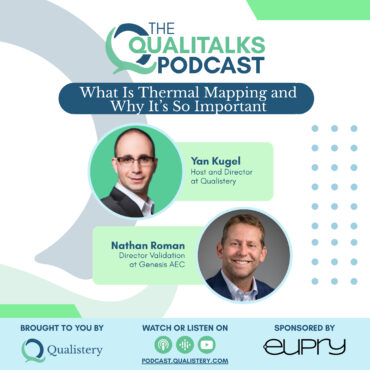
What Is Thermal Mapping and Why It’s So Important [Nathan Roman]
In this podcast episode, Nathan Roman, one of the top experts in Temperature control mapping, speaks about thermal mapping and its importance for pharmaceutical compliance.
Nathan Roman March 16, 2023 390 1

Table of Contents
Are you looking to learn more about how to validate a temperature-controlled chamber? Look no further! In this episode, we have Nathan Roman, one of the top experts in Temperature control mapping, to help us understand the different steps and regulations when validating a temperature-controlled chamber in the Health & Life Science industries.
Nathan will share his knowledge on the need for temperature-controlled chambers, the various types of chambers, regulations, common mistakes to be avoided, and resources for keeping up with best practices
Tune in to hear Nathan’s insights on validating a temperature-controlled chamber!
This episode is sponsored by Eupry, a leading provider of comprehensive environmental monitoring and validation solutions for regulated industries. With a focus on temperature, CO2, humidity, and differential pressure, Eupry helps companies ensure compliance with industry standards and regulations. All that while providing reliable and accurate data to support informed decision-making.
Temperature Controlled Chambers (TCC) are essential pieces of equipment used in various industries, going from aerospace to the pharmaceutical industry. Because of the criticality of storage temperature in the pharma industry, the temperature of these chambers must be regularly tested and validated. This article will discuss what a TCC is, the types available, the validation steps, and the associated regulations. It will also provide an overview of the most challenging step in validating a TCC and resources to help stay up-to-date with best practices and regulations.
A Temperature Controlled Chamber is a device used to provide a regulated temperature environment for testing products, components, and materials. They are used to test the effects of temperature on products, components, materials, and devices according to industry standards. A TCC must be used correctly to ensure the accuracy of testing results.
A TCC consists of a chamber, a thermostat, and a temperature sensor. The chamber is typically made of metal and is insulated to maintain the desired temperature. The thermostat is used to control the temperature and is often adjustable or programmable so that the user can set the desired temperature. The temperature sensor is used to detect and measure the temperature inside the chamber.
Temperature control chambers come in various sizes and shapes, depending on the type of testing or research needed.
The most basic and cost-effective type of TCC is a single-zone chamber. These chambers are limited in temperature range but provide an ideal environment for temperature-sensitive material or product testing. A single-zone chamber typically consists of an insulated chamber, a heating element, and an air-cooling system.
Multi-zone TCCs are the most advanced type and provide several benefits, such as multiple temperature zones, greater temperature ranges, and faster temperature changes. These chambers are typically used for more technical and demanding tests, such as a computer or automotive component testing. Multi-zone chambers are also ideal for applications that require precise temperature control, such as pharmaceutical tests.
No matter what type of temperature control chamber you need, it is crucial to carefully evaluate your requirements before purchasing. Temperature control chambers are expensive pieces of equipment and should be selected with care to ensure that the acquired equipment is suitable for your specific application needs.
TCCs are used in various industries to provide a consistent environment for testing and processes. To ensure the best results, it is important to adhere to regulations related to TCC validation.
Temperature Controlled Chamber validation typically involves ensuring a few key aspects, including accurate temperature and humidity readings and accurately cycling within set limits. To begin the validation process, ensure the data recorder works correctly, and the chamber is powered on. Next, carry out a 48-hour temperature ramp test. This test should ensure that the temperature is accurately cycled from its highest to its lowest levels and back. It should also be tested to make sure that temperature readings are correct.
Once the test is complete, check for leaks by forcing the chamber to reach a higher pressure level than normal. If any leaks are detected, the chamber must be repaired. Finally, record all data from the tests and carefully analyze any deviations from the expected results.
In addition to TCC validation, there are also several regulations in place for operating this type of equipment. These regulations include adhering to the listed temperature and humidity levels, maintaining parts and accessories, and using recommended protective equipment when conducting experiments within the chamber. The chamber should also be routinely inspected to ensure no damage or irregularities have occurred.
The objective of these regulations is that manufacturers, researchers, and medical providers rely on accurate and consistent results.
Attention all pharma professionals!
Stay ahead of the game and be fully compliant with regulations.
Join Qualistery’s expert-led educational webinars and stay up-to-date with the latest trends and regulations.
With top industry providers as our partners, we bring you the best speakers and informative sessions.
Visit our website to browse our upcoming webinars and take the first step toward furthering your knowledge and success in the industry.
Don’t miss out on this opportunity to invest in your professional growth.

Validating a TCC is an important step in ensuring that it meets industry standards and customer requirements. When validating a TCC, several steps should be performed:
1. Establish a temperature control protocol: To begin the validation process, establish a written and properly documented temperature control protocol. This should include the desired temperature range, the type of temperature recorder to be used, the calibration frequency, the acceptance criteria, the experiment duration, the sampling locations, the chamber load, and the procedure for recording all the data.
2. Calibrate the temperature recording devices: The data loggers and any other temperature recording device used for the TCC validation should be calibrated beforehand. This should be done regularly to ensure that all readings are accurate.
3. Perform a temperature mapping study: The study will assess the chamber’s temperature distribution at different times. Therefore, the data loggers should be placed at specific positions to get a representative temperature profile.
4. Perform a process capability study: Assess the chamber’s ability to maintain the desired temperature range over time. This is done by performing a process capability study, which will determine the chamber’s performance with respect to customer requirements.
5. Retrieve the data and write the validation report: Transfer the data from the data loggers to a computer and analyze the results. After a thorough review of the data, a report with all of the findings should be written.
By following these steps, you can ensure that your Temperature Controlled Chamber meets the industry standards and customer requirements for validation. In addition, doing so will ensure the safety and accuracy of the products manufactured in the TCC.
The validation of a TCC is essential to ensure that the chamber functions accurately and within the desired specifications. However, while validating a Temperature Controlled Chamber, a series of common mistakes can cause delays or, worse, inaccurate results. Here are some of those critical mistakes to avoid when validating a TCC:
1. Not following validation procedures correctly – It is important to follow established procedures when validating a TCC. This includes ensuring that all procedures are followed correctly, including calibrating the chamber regularly. Not following the proper procedures when validating a TCC can lead to inaccurate results and wasted time.
2. Not documenting the results accurately – Accurate documentation is essential for validating a TCC. Not accurately recording results can lead to various problems, including the usage of non-calibrated devices and inaccurate readings. Therefore, it is important to document all measurements and results accurately to ensure the integrity of the data.
3. Not using qualified personnel – It is crucial to have qualified personnel performing the validation of a TCC. Qualified personnel should have the knowledge and experience to calibrate and validate the chamber accurately. Otherwise, incorrect calibration or readings and valuable time could be wasted.
4. Not checking the chamber for wear and tear – Checking the TCC for wear and tear is important for ensuring the chamber functions properly. If the chamber is not in top condition, it could cause incorrect readings and inaccurate results.
Avoiding these common mistakes when validating a TCC can save valuable time and ensure accurate results. By following established procedures and using qualified personnel, you can ensure that the validation of your TCC is performed correctly and quickly.
Validation of a Temperature Controlled Chamber is a complex process with many variables that must be considered. To ensure the equipment’s accuracy, safety, and consistent performance, laboratories must stay up-to-date with the latest regulations and best practices.
Luckily, various resources and materials are available to those who need to validate a TCC. These include industry-specific organizations, books, online resources, conferences, and seminars.
Industry-specific organizations, such as the International Association of Temperature Control (IATC) and the International Society for Temperature Control (ISTC), provide valuable resources for validating a temperature-controlled chamber. The IATC and ISTC offer a range of publications, online learning materials, and industry events.
In addition to books and industry organizations, the internet is an excellent source of information when validating a temperature-controlled chamber. Many websites offer information on best practices, regulations, and standards. However, it is important to note that only reliable websites should be used, and any information should be verified with industry regulations or standards.
Conferences and seminars provide an opportunity to hear from industry experts and learn more about the latest regulations and best practices. In addition, seminars and conferences offer an excellent opportunity to network with other professionals in the temperature control industry.
Finally, it is important to keep track of any changes to regulations and best practices that could affect the validation process. This can be done through several industry websites such as IATC and ISTC (among others) and by attending industry events.
By staying up-to-date on regulations and best practices, laboratories can ensure that their temperature-controlled chambers are appropriately validated. With the resources mentioned above, validating a temperature-controlled chamber can be made easier and more efficient.
Based on the steps outlined in this article, it has become clear that validating a Temperature Controlled Chamber is an important and challenging process. As a result of the complexity of the process, it is essential to develop a comprehensive plan that includes each step to be performed. Additionally, it is important to be aware of the potential challenges and common mistakes that could occur to ensure the best possible outcome for the process.
The best way to stay informed about the regulations and best practices for Temperature Control Chamber validation is to take advantage of the information and resources available, such as online resources, industry associations, and regulations from organizations like the FDA.
Professionals can ensure successful and safe operations by understanding the steps and best practices for validating a Temperature Controlled Chamber.
[simple-author-box]
[mailerlite_form form_id=1]
Tagged as: Temperature Mapping, Temperature Chamber Validation.
Over the last 22 years I’ve placed thousands of temperature sensors in hundreds of control temperature chambers. Building on that experience, I’m continuously improving my efficient processes for faster delivery of fully qualified chambers for use. My name is Nathan Roman, and I have a passion to help others. I help people in the Health & Life Science industry learn how to implement and carry out temperature mapping studies and equipment qualifications (IQ, OQ, PQ).

In this podcast episode, Nathan Roman, one of the top experts in Temperature control mapping, speaks about thermal mapping and its importance for pharmaceutical compliance.


Copyright © 2023 Qualistery